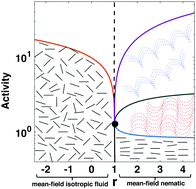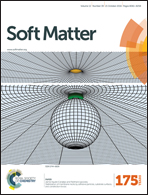Negative stiffness and modulated states in active nematics†
Abstract
We examine the dynamics of an active nematic liquid crystal on a frictional substrate. When frictional damping dominates over viscous dissipation, we eliminate flow in favor of active stresses to obtain a minimal dynamical model for the nematic order parameter, with elastic constants renormalized by activity. The renormalized elastic constants can become negative at large activity, leading to the selection of spatially inhomogeneous patterns via a mechanism analogous to that responsible for modulated phases arising at an equilibrium Lifshitz point. Tuning activity and the degree of nematic order in the passive system, we obtain a linear stability phase diagram that exhibits a nonequilibrium tricritical point where ordered, modulated and disordered phases meet. Numerical solution of the nonlinear equations yields a succession of spatial structures of increasing complexity with increasing activity, including kink walls and active turbulence, as observed in experiments on microtubule bundles confined at an oil–water interface. Our work provides a minimal model for an overdamped active nematic that reproduces all the nonequilibrium structures seen in simulations of the full active nematic hydrodynamics and provides a framework for understanding some of the mechanisms for selection of the nonequilibrium patterns in the language of equilibrium critical phenomena.


 Please wait while we load your content...
Please wait while we load your content...